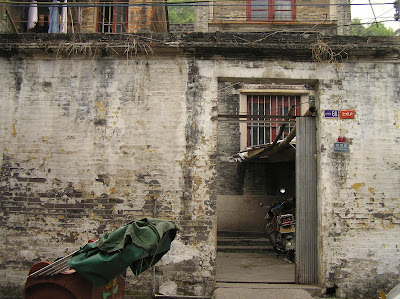The house is located in the city of
Zhongshan (中山),
Guangdong (廣東 - Guangdung) province,
China (中华人民共和国). Zhongshan was named after Sun Zhongshan (孫中山 -
Sun Yat-sen) just after his death in 1925. The prior name of Zhongshan was Xiangshan (香山 - Hoeng Saan or "Fragrant Mountain") County. Sun, a medical doctor, revolutionary, military and political leader, is widely regarded as the political father of modern China, and was born in Xiangshan in 1866. Xiangshan was established in 1152.
Dr. & Madam Sun statues. Zhongshan Overseas Chinese Society Building, Zhongshan.
Within
Zhongshan, the house is located in
Shiqi1 (石岐 - Sekkei) District in a village called Zhongshan Gongyuan (公園 - Gungjyun) which means Zhongshan "Common Garden" or "Park". It is also the name of the Zhongshan City Park (中山公園), where the main geophysical feature is Yandunshan (烟墩山 - Jindeunsaan or "Mount Yandun"), now also called Fufeng (阜峰 - Fufung) which means "mound top". Atop the mountain is a 1983 reconstruction of
Yandunshan Ta, (烟墩山塔 - Jindeunsaan Taap or "Mount Yandun Tower"), a copy of the seven-story, brick, octagonal pagoda, 80 feet high, that was originally contructed in 1608 during the
Ming Dynasty (1368 - 1644). The mountain and its tower stand over the entire city.
Yandunshan Ta, Zhongshan City Park.
Yandunshan Ta view from the 10th floor of the Golden Diamond Hotel on Kanghua Lu.
Yandun means "smoking brush", and legends have it that fires were started on the mountain top either to direct fisherman to port at Shiqi or to warn of invading pirates
2. Yandun also refers to the fishing village on the Qijian River just west of the mountain that was established during the
Southern Song Dynasty (1127 - 1279)
3. The bank of the Qijian River, a branch of the
Pearl River, lies about a quarter mile from Yandunshan Ta, which is about the same distance from the house.
During the non-
Han Chinese
Manchu Qing Dynasty (1644 - 1912), noon in Shiqi was marked daily for the entire area by cannon fired from Yandunshan
4. However, the violent decline of China during the Qing Dynasty during the 19th century lead to the dissolution of the
Chinese imperial system (221 BC - 1916) that brought foreign and civil wars, ethnic violence, famine and despair throughout southern China.
Guangzhou (广州市 - Canton) was the focal point for the
Opium Wars, the
First Opium War (1839 - 1842) and the
Second Opium War (1856 - 1860), against the
British Empire. China's defeat in the First Opium War resulted in the forced trade of
opium upon China to address a huge
trade imbalance involving British purchases of tea. The military and economic setbacks as an outcome of the First Opium War, anti-Manchu sentiment, and moral and religious conflict contributed to the
Tai Ping Rebellion (1850 - 1864), a civil war in which an estimated 20 million perished -- at the time, the bloodiest military conflict in human history. Concurrently, ethic conflict in the Guangzhou region between the native
Punti and less settled
Hakka peoples erupted as the
Punti-Hakki Clan Wars (1855 - 1867) that resulted in about 500,000 deaths. In addition, the region was struck by an earthquake in 1881 and ice and snowstorms in 1892
6. With so much disruption, it should not be surprising why so many Guangzhou region Chinese, particularly from the Siyi (
四邑 -
Seiyap or "Four County") area, immigrated throughout the world during the latter part of the 19th century, particularly with the
discovery of gold at
Sutter's Mill in California in 1848.
Gongyuan park and village gate on Guangming Lu looking north into Yixianhu Park.
The house abuts the northern boundary of Zhongshan City Park. Its address is 68 Shan Feng Jie (山凤街 - Saan Fung Gaai or "Mountain Phoenix Street"). The mountain refers to Yandun, so the street is appropriately referred to as Phoenix Street or Yandun Mountain Phoenix Street.
Address on courtyard wall. All houses on Phoenix Street have a red sign that says, "culture friendly family."
Phoenix Street's name memorializes a legend about the brave villagers who once lived on the north side of Yandunshan and rid the locale of a tiger that inhabited an area centered at a pond in a nearby
mango grove
5. A young woman weaver who had recently married the local baron came up with the idea of denying the tiger water by cutting-off access to the pond using a fence made of mango branches woven together with reeds. The baron and his wife started weaving together the fence and were soon joined by the villagers. In a about two weeks the fence was put up and the thirsty tiger left the area. The grateful villagers said the woman was like a flying Yandunshan
phoenix (
凰).
FOOTNOTES
1 The meaning of Shiqi's name is not clear. The Zhongshan City governmment website contains an
article that argues that Shi (石) means "stone" based on an assertion that Yandunshan was initially called Stone Mountain (Shishan) before it was used as a platform for smoke signals; and that Qi (岐) means "discriminate" or "differences" based on construction of two stone dikes long ago that made one approach to the community more favorable than the other.
2
Zhou Zhenjie, Wufei Xiong, and Zheng Jianling, "Shadow of Shiqi: Yandun", Zhongshan Daily, May 23, 2006, No. 335 page B6. (
Using Google translator.)
3 Ibid.
4 Ibid.
5 Ibid.
6 Kehrer, Jonathan G.,
"Timeline for Taishan County", August 24, 2001, accessed April 16, 2011.
LINKS
A compilation of Zhou Zhenjie's
Zhongshan Daily articles is available on his
blog site. (
Google translation.) Unfortunately, it does not include most of his articles about Shiqi.

















